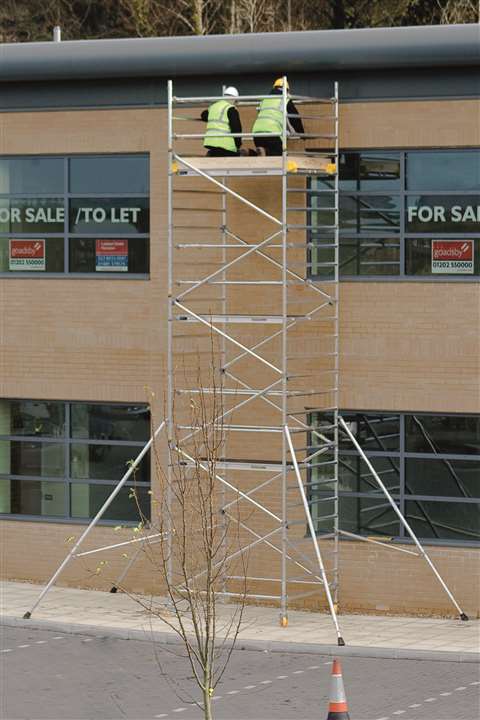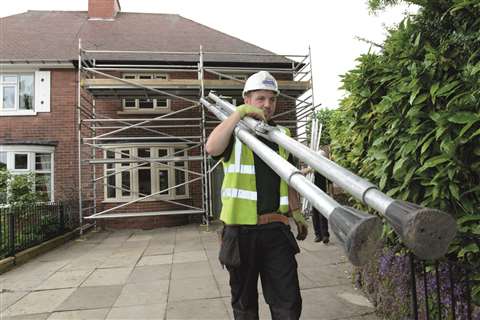Mobile towers - new standards explained
07 September 2021
The mobile tower industry is taking steps to ensure safer work at height, with the rollout of the European EN1004-1 product standards. Sophie Ellam, product manager for WernerCo, which manufactures BoSS towers, discusses what these changes mean for the industry and how to ensure employees stay safe working at height.
Work at height can be a dangerous business. For example, in the UK, falls from height is the leading cause of workplace fatalities and of these incidents, 25% of the number of workers killed in 2020/21 were due to a fall from height. These accidents happened predominantly in the construction sector, and the latest figures have shown a rise compared to the same periods between 2016 to 2020.
 The EN1004-1 standard for mobile access towers comes into force In November.
The EN1004-1 standard for mobile access towers comes into force In November.
The positive news is that while this is still a great cause for concern, the UK and Ireland has one of the lowest incident rates compared to the rest of Europe. However, there are certain precautions that employers can take to ensure their staff remain safe on site. Crucially this involves ensuring that equipment used is fit for purpose and up to standard and that all staff are fully trained for working at height safely.
In November, new product standards will be introduced on all mobile access towers, creating a safer working at height environment within the construction industry. EN1004-1 is a revision to the current EN1004:2004 standard and will come into force in November 2021 following a 12-month transition period, during which time product modifications have been made and tests have been undertaken to ensure all products that fall into the scope of the EN 1004 Standard conform and are certified.
The standard will cover what materials, dimensions, design loads, safety and performance requirements mobile access towers should conform to. Under the scope of the changes, towers up to 8m externally and 12m internally will still be covered, but now those under 2.5m will also be included in the standard.
The standard only covers mobile access towers and does not apply to cantilevers, towers on stairs, towers with bridges, low level work platforms, large deck towers and non-standard towers. These are all covered by BS 1139-6, except for low level work platforms, which is covered by BS 8620.
In the changes to EN1004-1 there are four main areas that have been looked at, as well as further clarifications of existing guidance. The key points of the revision ensure that there is a reduction in the distance between platform levels with a maximum of 2.25m, down from 4.2m, and WernerCo is proud that BoSS towers already conform to this change as all access towers have always had a 2m distance between platforms.
Further measures have been brought in to ensure there is a shorter distance from the ground to the first platform, which is now a maximum of 3.4m, down from 4.6m and to prevent castors from falling out. More safeguards on towers include additional windlocks on decks at both ends, meaning they won’t uplift in the wind, and the standards provide new guidance on wind and gust loads.
These changes make good news for the industry as it means we’ll expect to see further innovation on products and for manufacturers it provides more freedom to develop towers that better suit our end user’s needs. This is due to two main changes being introduced, firstly for towers with a work platform below 2m it’s now possible to develop products that allow access from outside the tower – if strict rules on stability are followed.
Online guide
WernerCo is putting all of its BoSS products through third party testing to provide additional levels of assurance through official certification, to ensure that they comply with this revision.
While these changes will set the new standard for any new products coming out, users can still use their existing fleet of mobile access towers providing they comply with EN1004:2004 and are still in a suitable condition.

WernerCo has created an online guide for all its customers to explain what the changes mean and how they will affect users, it also explains what users should look for when purchasing new equipment and how to identify if a tower complies. The easiest way to check this is to refer to the manufacturer’s user instructions and check the product label.
It’s not just the suitability and safety of products that contribute to a safe work at height environment but it’s also down to the end user to ensure they are protecting themselves whilst at work. WernerCo has created some handy guides in partnership with industry association PASMA to ensure users are choosing the right equipment and working safely with towers.
The guides cover both standard and complex tower builds, what situation is best to use them and advice on inspecting and recording when working with towers. It is always recommended that towers are built to an approved method, which includes using an Advance Guardrail or Through the Trapdoor, and follows manufacturer’s build instructions.
One way to ensure you’re fully protected when working at height is to undergo formal work at height training. WernerCo offers approved PASMA training, including the PASMA accredited Towers for Users Course and more advanced training for those working with more specific tower builds, where standard towers have been modified to meet more complex requirements.
The PASMA accredited Towers for Users course is designed for those who are responsible for specifying, assembling, dismantling, using, altering, moving and inspecting access towers. The course runs for one day and provides both theoretical and practical training on tower legislation; PASMA codes of practice; hazards associated with using mobile access towers; and what should be avoided.
PASMA’s advanced training covers those working with specific tower builds where standard towers have been modified to meet more complex requirements. In addition to the Towers for Users course the association also delivers a range of specialist courses, covering topics such as cantilevers, towers on stairways and linked towers. After the session, delegates are given the opportunity to remain in touch with the manufacturer of the tower for any further advice.
WernerCo is urging people to check that their training is up to date as we’re finding people haven’t realised their PASMA cards have expired during lockdown and haven’t been renewed. Also, with output increasing, more companies will be looking to take on employees, some of whom may not have had the appropriate training.
The facts can’t be ignored. Falls from height still remain one of the most common causes of injury in the workplace and continue to occur in the thousands. In order to ensure these numbers continue to decrease, we as an industry and manufacturers need to continue to work together to ensure we’re doing all we can to ensure safe working practices and products are available to bring the number of life changing accidents down.
Click here for more information on the changes and the BoSS’ EN1004-1 guide.
STAY CONNECTED



Receive the information you need when you need it through our world-leading magazines, newsletters and daily briefings.
CONNECT WITH THE TEAM








